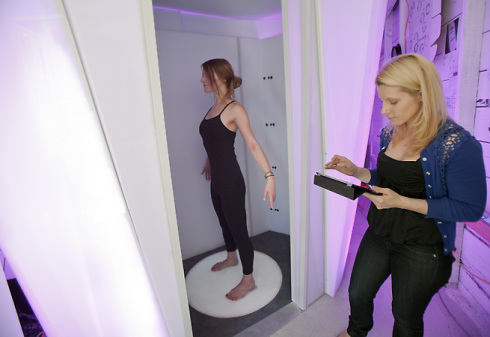
Example of 3D body scanner for fashion purposes.
Morgan and Daina Linton’s Fashion Metric is one hot start-up right now, being a part of the Mark Cuban group of companies. The effectiveness of its apparel measuring technology is one of the best in the clothing market, but how effective is it for taking full body measurements?
For something like this, one needs to utilize full 3D body scanning technology.
Maxwell Arnold, domain investor and fashion technocrat extraordinaire, took a dive into the underlying technology for truly custom made clothing, that requires one to don nothing but their birthday suit!
Copyright © 2025 DomainGang.com · All Rights Reserved.A topic that has been much discussed in the fashion world in the last few years has been 3D body scanning. For those of you who are unfamiliar with what it is, it’s a technology that scans your body, to determine what your measurements are, so that garments can be custom-made for you based on those measurements – which has an excellent surface appeal to people who have a hard time finding clothes that fit.
However, I have always been a critic of the technology. I have two major problems with it…
1. It requires you to be essentially naked to be scanned
While this isn’t a big deal to me, personally – it will bother a lot of people to stand in front of sensors that look a lot like cameras, especially if they have body image issues. Aside from the general awkwardness, this technology is actually meant to be used in a retail setting. Which, to me, is completely impractical. I know people who feel weird using fitting rooms in clothing stores, where nobody can see them. Can you imagine how much of a step standing in a 3D body scanning booth would be?
2. The customer has to know exactly what they want
Since the technology basically goes on to make custom-created garments for a given wearer, the customer can’t “shop around”. The whole thumbing-through-the-racks-of-hangers jaunt. As tedious and mundane as it may be, that’s all part of going shopping. Can you envision sitting in front of a computer, trying to think of what you want to have made? It simply isn’t going to happen! Many of us live for a “day at the mall”, and this sort of experience is completely incompatible with what 3D body scanning does in a retail environment.
So, let’s get onto the actual topic; the line between “relevant” and “useful”.
Something like 3D body scanning, in concept, is actually very relevant to quite a bit of the clothing market. For instance, I always have to have my shirts altered, because they’re usually too big on the torso. So, it would seem that having them custom made is actually a more viable option. It’s relevant to me, because fit is often an issue.
But it’s not useful to me, as I do not always know what I want. I’m personally into moderately funky patterns. I can’t dream up the coolest-looking or most stylish designs (despite being almost finished with an undergraduate degree in fashion). The fact is, I’ll know one when I see one – which is typically done by the age-old practice of going shopping.
As this is something there is no substitute for, it limits how useful 3D body scanning technology stands to be. My money leaves my pocket as a result of going shopping – because that’s how I enjoy shopping for clothes. If that’s not how I can shop for clothes, my money does not leave my pocket. Simple.
What is this a lesson in? It’s a lesson in treating usefulness as a pinnacle point of assessment in whatever innovation you might be in the works of coming up with.
Here are a two examples of technology that have a relevance/usefulness imbalance;
QR Codes – they are relevant to smartphone users, in the sense that you can directly access information about an advertisement on the go, using your smartphone. It lacks utility, however, in that the information is on the internet. To access the internet, usually one goes… well… to the internet. To have to open a completely separate application, hold your phone up to a mysterious little box, let it focus, take a picture, process the information, and then… open up a little application called (you guessed it) the internet, seems a little… redundant, doesn’t it?
Additionally, it requires your phone to be on, and connected to the internet. Something that’s not always the case, especially if you have an older smartphone with terrible battery life. A perfectly plausible way around this, is a good old fashioned URL. You can write it down, remember it mentally, or type it into your web browser directly, as opposed to having to go the route of a cumbersome application.
Relevant: Allows users to access advertisement data on their smartphones.
Not useful: Requires an awkward multi-step application process, and its function is limited to those with a smartphone that is both on, and connected – which specifically eliminates the possibility of being used in remote areas, or underground areas with little or no cellular reception.Facebook “stickers” – we’re expressive people. Contemporary artistry forms, especially during the Art Deco era of the 1960’s is an excellent indicator of this. Ever since we started to communicate through text in the 1990’s, that did not express our ability to express ourselves – which is where the emoticon concept came from, where many a tone of conversation was set with a :), :(, ;), or 😀 – and was taken even further with Apple treating “emoji” as its own language, on its iOS devices.
This makes communication a bit more interesting. Of course, as soon as it takes off, every hotshot go-getter will go on and make their own “next level” version of that concept. The emoji library on iOS has been ever-evolving for this exact reason – and there are many apps on the market now that allow you to make your own custom emojis.
So, clearly, expressing ourselves is something that we want to be able to do. Facebook jumped on this bandwagon by offering “stickers”. They dance, act cool, and can add a new dimension of expression to a dialogue… but what are they, other than emojis that move? Oh, right… they’re emojis that move… and cost money. Nice one, Facebook.
You see, we live in a generation where people will literally sign up for multiple free Netflix trials in a row, to avoid paying $8.00 per month, and skip through ad after ad in “lite” versions of apps, just to avoid paying $0.99 for the full version.
Do you seriously think that people will pay even a dollar to see these jumbo emojis go dancing? I’m actually chuckling at the fact that anybody even had that thought.
Relevant – People want to express themselves. As they always have wanted to.
Not useful – If it costs money to express yourself in a way that there are readily available substitutes for, you’re essentially stuck, trying to profess value of some sort to a generation who values “free” over all else.—
This is simply a principle of analysis, to determine whether people will actually use your technology. You can make as many reports as you want to prove that it’s relevant to your target market – but if there is something that is a barrier to them using it – you will not be able to cultivate a consistent user base.
If Larry Page’s “toothbrush rule” comes to mind here you’re thinking in the right terms. The way he uses to think about acquisitions for Google to make (in terms of it being something you’ll use every day, such as a toothbrush) thinks in terms of regular usage.
Even the most brilliant technology will not succeed if it is not used. That is the barrier that must be broken, in order for your product to succeed – which is why every penny invested into customer experience, and user experience, is what could well make or break your venture.
For a more detailed coverage of this thesis, click here to view my article on LinkedIn.











Should i keep 3dScanningBooth.Com ??